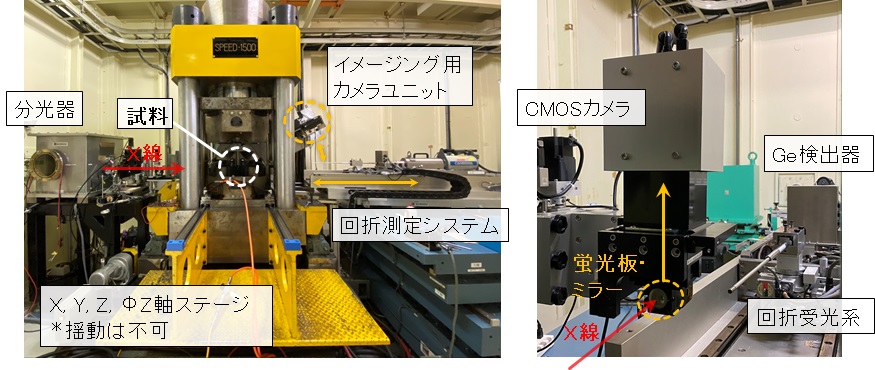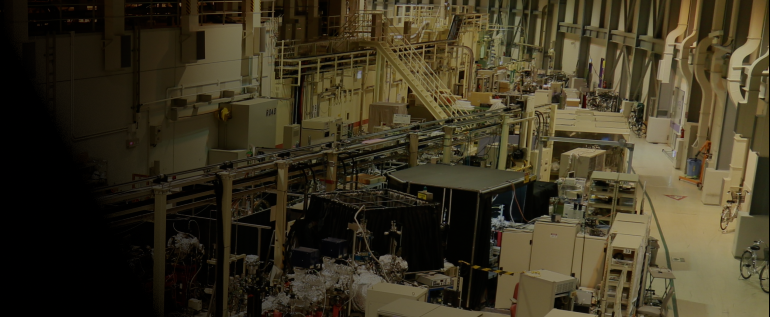大容量高圧発生装置(SPEED-1500)
◆装置概要
大容量試料(~mm3)を約30GPaまで加圧&加熱できます。高圧高温環境下でのXRD測定、X線吸収像の観察のほか、弾性波速度や電気抵抗率などの物性測定も可能です。

◆装置の特徴
本システムは、比較的大型の試料(~mm3)を多軸圧縮で準静水圧環境下に晒すことができます。また、高圧セル内部の抵抗ヒーターで安定的に加熱できることから、高圧新奇物質のその場合成に適しています。高圧高温状態の試料に白色X線をそのまま照射して、X線吸収像の観察やXRD計測がおこなえることから、高圧相の相転移境界の決定、バルク試料の物性測定が可能です。高圧プレス
本装置は2段押しの川井型高圧発生装置であり、最大1500トンの荷重を試料に加えることができます。1軸油圧ラムとDIA型ガイドブロックを組み合わせて、荷重を6方向に分割して、高圧セルを均等に加圧できます。2段目に超硬合金製アンビル使用すると最大30 GPa程度の高圧発生が可能です。高圧セル内部に抵抗加熱式ヒーターを組み込むことで3000℃までの加熱が可能です。
X線ビームモニター
X線吸収像の観察には浜松ホトニクス製のX線ビームモニターを使用しています。GAGG蛍光板で可視光に変換し、汎用のカメラ用光学レンズで結像します。カメラは同じく浜松ホトニクス製の科学計測用のsCMOSカメラを使用しています。見かけの分解能は約3μm/pixとなります。
Ge-SSD
XRD計測にはエネルギー分散型のX線回折法を採用してします。回折X線のエネルギースペクトル測定にはミリオンテクノロジーズ・キャンベラ社製のGe-SSDを常設しており、測定可能なエネルギー範囲は10~150keVです。
◆装置アクセサリー
上記の高圧プレスで加熱するための、交流電源(2kW)と直流電源(1.6kW×2)を備えており、小型ヒーターに大電流(~300A)を印可して試料を数千度まで加熱できます。
これらのX線計測機器の他に、試料の弾性波速度(弾性率)を測定するための超音波エコー測定システムや、4端子法で電気抵抗測定が可能なデジタルマルチメーターがある。
◆実験・試料準備
基本的に一段目アンビルには一辺50mmのハイス鋼製アンビルを使用し、二段目アンビルには一辺26mmの超硬製アンビルを使用します。焼結ダイヤモンド製二段目アンビルは、より高精度のアンビル面間距離の調整が可能なSPEED-MkⅡの使用を推奨します。トランケーションサイズ(TEL)は3~12mmの範囲が一般的ですが、TELが8mm以上ではX線吸収が非常に大きいため、ガスケットにボロン製のX線窓準備したほうがよい。
一般的なスリットサイズで2θ=6°の場合、回折領域は約1mmであり、試料径は1mm以上が望ましい。試料径がそれ以下の場合は試料以外のX線回折ピークが混入する。
高圧セルを組み立てた後は十分に乾燥させ、デシケーターで保管する。
◆実験手順・注意事項
実験手順の詳細はBL担当者にお聞きください。
一般的な実験手順として、
(1)高圧セル、試料準備
希望する圧力・温度・酸素雰囲気等により高圧セルを設計、パーツを製作する。試料は粉体のペレットもしくは焼結体を用意する。
(2)装置校正
Ge-SSDのエネルギー校正、水平ゴニオメーターの2θ補正をおこなう。
(3)高圧セル設置&常圧測定
加圧前の試料の状態をX線ラジオグラフィーで確認し、XRDデータを取得する。常圧データはその後の高圧データを定量的に議論する際に非常に重要であり、圧力の計算にも欠かせない。
(4)加圧&圧力測定
大型プレスで高圧セルを加圧する。通常3~5ton/minでゆっくり加圧する。加圧中に高圧セル内の圧力標準物質のXRD測定によって得られる結晶格子の縮みから発生圧力を計算し、目標圧力に達するまで、加圧&圧力測定を繰り返す。通常数時間はかかる。
(5)加熱&データ測定
目標圧力に達した後に、内部ヒーターによる加熱を開始する。加圧によるヒーター変形があるため、ヒーターの安定性に注視しつつ、目標温度まで加熱する。昇温しつつ試料のXRDデータを取得して、相変化や格子定数変化をその場観察する。
圧力―温度平面上で多数のデータを取得する場合は(4)~(5)を繰り返す。
チェ―ブロックによる高圧セルの設置の際や、大型プレスの操作時は重大事故につながる恐れがあるため、特に注意が必要です。
また、白色X線は照射物を著しく損傷させます。X線の軸上に不用意にケーブルや検出器等を設置しないようにお願いします。
◆問い合わせ先
肥後祐司 このメールアドレスはスパムボットから保護されています。閲覧するにはJavaScriptを有効にする必要があります。
丹下慶範 このメールアドレスはスパムボットから保護されています。閲覧するにはJavaScriptを有効にする必要があります。
◆代表的な論文リスト
Formation of bridgmanite-enriched layer at the top lower-mantle during magma ocean solidification
L. Xie, A. Yoneda, D. Yamazaki, G. Manthilake, Y. Higo, Y. Tange, N. Guignot, A. King, M. Scheel & D. Andrault
Nature Communications 28 Jan. 2020:
Vol. 11, no. 548.
DOI: 10.1038/s41467-019-14071-8
Sound velocity of CaSiO3 perovskite suggests the presence of basaltic crust in the Earth’s lower mantle
S. Gréaux, T. Irifune, Y. Higo, Y. Tange, T. Arimoto, Z. Liu & A. Yamada
Nature 09 Jan. 2019:
Vol. 565, pp. 218-221
DOI: 10.1038/s41586-018-0816-5
Curious kinetic behavior in silica polymorphs solves seifertite puzzle in shocked meteorite
T. Kubo, T. Kato1, Y. Higo and K. Funakoshi
ScienceAdvance 08 May. 2015:
Vol. 1, no. 4 e15000075
DOI: 10.1126/sciadv.1500075
Sound velocities of majorite garnet and the composition of the mantle transition region
T. Irifune, Y. Higo, T. Inoue, Y. Kono, H. Ohfuji & K. Funakoshi
Nature 14 Feb. 2008:
Vol. 451, pp. 814-817
DOI: 10.1038/nature06551
The Postspinel Phase Boundary in Mg2SiO4 Determined by in Situ X-ray Diffraction
T. Irifune, N. Nishiyama, K. Kuroda, T. Inoue, M. Isshiki, W. Utsumi, K. Funakoshi, S. Urakawa, T. Uchida, T. Katsura, O. Ohtaka
Science 13 Mar 1998:
Vol. 279, Issue 5357, pp. 1698-1700
DOI: 10.1126/science.279.5357.1698
Large Capacity, High-Pressure Generating Equipment (SPEED-1500)
◆Equipment overview
Large capacity samples(~mm3)can be pressurized and heated to about 30GPa. In addition to XRD measurements and X-ray absorption images in high-pressure, high-temperature environments, it is also possible to measure the properties of elastic wave velocity and electric resistivity.

◆Features of the Equipment
This system can expose relatively large-sized samples(~mm3)to multi-axis compression in a quasi-hydrostatic environment. Also, since it can be heated stably with a resistance heater inside a high-pressure cell, it is suited for cases of high-pressure substances. Since white X-rays can irradiate samples in high temperature, high pressure states, and observe absorption images and XRD measurements, it is possible to determine the phase transition boundary and the physical properties of bulk samples.High-Pressure Press
This equipment is a 2-stage, Kawai-type high pressure generator that can apply loads up to 1,500 tons per sample. A single-axis hydraulic ram and a DIA-shaped guide block are combined to separate the load in 6 directions, used to evenly pressurize the high-pressure cells. In the second stage, a cemented-carbide anvil is used to generate high pressures of up to 30Gpa. By incorporating a resistance heater inside the high-pressure cell, it is possible to heat to 3000℃.
X-Ray Beam Monitor
X-ray absorption images are observed using an X-ray beam monitor manufactured by Hanamatsu Photonics. It is converted to visible light using a GAGG fluorescent plate, then imaged with a general-purpose optical camera lens. The camera used for scientific measurements is a sCMOS camera, also manufactured by Hanamatsu Photonics. The apparent resolution is approximately 3μm/pix.
Ge-SSD
XRD measurement uses energy-dispersive X-ray diffraction. Measurements of the X-ray diffraction energy spectrum are completed using a permanently installed Ge-SSD manufactured by Mirion Technologies (Canberra), with a measurable energy range of 10~150keV.
◆Equipment accessories
For heating with the above high-pressure press, an AC power supply of (2kW) and a DC power supply of(1.6kW×2)is equipped, a large current(~300A)can be applied to a small heater to heat the sample to several thousand degrees.
In addition to these X-ray measurement instruments, there is an ultrasound echo measurement system used to measure the elastic wave velocity (modulus of elasticity) of the sample, as well as a four-terminal digital multimeter to measure electric resistance.
◆Experiment / sample preparation
For the first anvil, a heiss steel anvil of 50mm is used, and for the second anvil, a carbide anvil of 26mm is used. It is recommended that the second stage anvil sintering diamond system is used for the SPEED-Mk II, which allows for more precise adjustments between the anvil surfaces. The truncation edge length (TEL) is generally within a 3~12mm range, but X-ray absorption is very large when the TEL is 8mm or above, so it is better to prepare an X-ray window made of Boron for the gasket.
When 2θ=6°is the slit size, the diffraction field is approximately 1mm, and therefore the sample diameter of approximately 1mm is desirable. When the sample diameter is less than that, the X-ray diffraction peaks of the sample are mixed.
After the high-pressure cells are assembled, dry them and store them in a desiccator.
◆Experimental procedure / precautions
For details on experimental procedures, please ask the person in charge of the BL.
General experimental procedure,
(1)High pressure cell, sample preparation
High-pressure cells are designed and created depending on the desired pressure, temperature, oxygen atmosphere, etc. The sample is prepared using powdered pellets or sintered bodies.
(2)Instrument Calibration
Ge-SSD energy calibrations and 2θ goniometer calibrations are performed.
(3)High-pressure cell installation and standard pressure measurements
The state of the sample before pressurization is confirmed by X-ray radiography, then XRD data can be acquired. The constant pressure data is significant for quantitative discussions of high-pressure data, and is essential for computing pressure.
(4)Increasing Pressure and Pressure Measurements
The high-pressure cell can be pressurized with the large press. It usually takes 3~5ton/min to slowly pressurize. During pressurization, the generated pressure is calculated from the shrinking of the crystal lattice structure, obtained by XRD measurements of the high-pressure cell inside the substance. The pressurization and pressure measurements are repeated until the target pressure is reached, which usually takes several hours.
(5)Heating & Data Measurements
After reaching the target pressure, heating is started with an internal heater. Since there is a heater transformation due to pressurization, it must be heated to the target temperature while the stability of the heater is carefully observed. The XRD data of the sample is acquired while the temperature rises, and phase changes as well as lattice changes are observed.
Repeat (4) ~ (5) when a large amount of data is acquired on the pressure – temperature plane.
Special care must be paid to the installation of high-pressure cells with chain blocks, as well as when operating large presses, as this may lead to serious accidents.
Also, white X-rays significantly damage whatever they irradiate. Please no not install cables, detectors, etx on the X-ray axis.
◆Contact
肥後祐司 このメールアドレスはスパムボットから保護されています。閲覧するにはJavaScriptを有効にする必要があります。
丹下慶範 このメールアドレスはスパムボットから保護されています。閲覧するにはJavaScriptを有効にする必要があります。
◆List of representative treatises
Formation of bridgmanite-enriched layer at the top lower-mantle during magma ocean solidification
L. Xie, A. Yoneda, D. Yamazaki, G. Manthilake, Y. Higo, Y. Tange, N. Guignot, A. King, M. Scheel & D. Andrault
Nature Communications 28 Jan. 2020:
Vol. 11, no. 548.
DOI: 10.1038/s41467-019-14071-8
Sound velocity of CaSiO3 perovskite suggests the presence of basaltic crust in the Earth’s lower mantle
S. Greaux, T. Irifune, Y. Higo, Y. Tange, T. Arimoto, Z. Liu & A. Yamada
Nature 09 Jan. 2019:
Vol. 565, pp. 218-221
DOI: 10.1038/s41586-018-0816-5
Curious kinetic behavior in silica polymorphs solves seifertite puzzle in shocked meteorite
T. Kubo, T. Kato1, Y. Higo and K. Funakoshi
ScienceAdvance 08 May. 2015:
Vol. 1, no. 4 e15000075
DOI: 10.1126/sciadv.1500075
Sound velocities of majorite garnet and the composition of the mantle transition region
T. Irifune, Y. Higo, T. Inoue, Y. Kono, H. Ohfuji & K. Funakoshi
Nature 14 Feb. 2008:
Vol. 451, pp. 814-817
DOI: 10.1038/nature06551
The Postspinel Phase Boundary in Mg2SiO4 Determined by in Situ X-ray Diffraction
T. Irifune, N. Nishiyama, K. Kuroda, T. Inoue, M. Isshiki, W. Utsumi, K. Funakoshi, S. Urakawa, T. Uchida, T. Katsura, O. Ohtaka
Science 13 Mar 1998:
Vol. 279, Issue 5357, pp. 1698-1700
DOI: 10.1126/science.279.5357.1698
